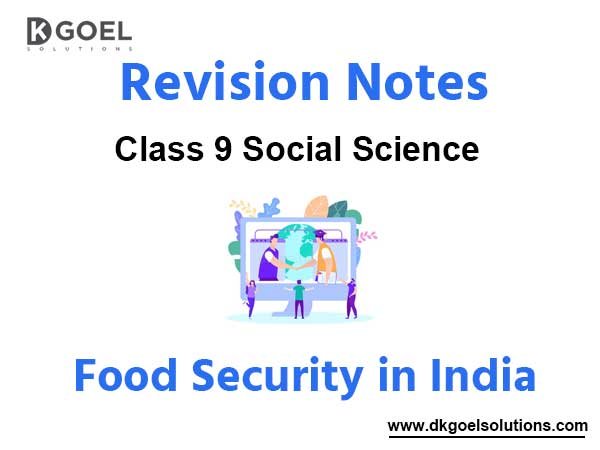Notes Chapter 4 Food Security in India
Food security means availability, accessibility and affordability of food to all people at all times.
Food security: The poorest section of the society remains food insecure all the times.
People above poverty line might also feel food insecure in times of natural calamity like earthquake, drought, flood, tsunami, etc.
Food – Insecure: In rural areas, the worst affected people are: landless and small farmers, traditional artisans (weavers, potters, blacksmith etc.) providers of services (e.g. barbers, washermen etc), petty self-employed workers and destitute. In the urban areas, persons employed in ill-paid occupations and casual labourers are food insecure.
Large proportion of pregnant and nursing mothers and children under the age of 5 years constitute an important segment of the food insecure population.
Hunger: Hunger has chronic and seasonal dimensions. Poor people suffer from chronic hunger and are food insecure all the times. Seasonal hunger is caused by the seasonal nature of agricultural activities in rural areas. In urban areas, seasonal hunger occurs because of the casual type of work. Thus, seasonal hunger exists when people are unable to get work for the whole year.
Need for self-sufficiency in food grains. Our government since Independence realised the need to attain self-sufficiency in food grains because India experienced acute shortage of food grains after partition of the country in 1947. The need for self-sufficiency arises from the following:
(a) to feed rising population
(b) to fight against droughts, floods, cyclone, etc.
(c) to reduce import of food grains
(d) to control prices of food grains.
Food Security System in India: Since the advent of the Green Revolution in the 1960s the country has avoided famine, even during adverse weather conditions. India has become selfsufficient in food grains during the last 30 years because of the variety of crops grown all over the country. Also, we have developed a food security system.
Buffer Stock: Buffer stock is the stock of food grains (wheat and rice) procured by the government through the Food Corporation of India (FCI). The FCI purchases wheat and rice for the government from the farmers of surplus states at pre-announced prices. This price is called ‘minimum support price’.
Public Distribution System (PDS): PDS refers to a system through which the food procured by the FCI is distributed among the poor through government regulated ration shops. The consumers are issued ration cards.
Kinds of Ration Cards. There are three kinds of ration cards:
(a) Antyodaya cards for the poorest of the poor,
(b) BPL cards for those below poverty line and,
(c) APL cards for those above poverty line.
Three Important Food Intervention Programmes:
In the wake of high incidence of poverty levels in mid-1970s, three important food intervention programmes were introduced:
(a) Public Distribution System (in existence earlier)
(b) Integrated Child Development Services (ICDS) in 1975
(c) Food for work in 1977-78.
In 2000, two special schemes were launched viz. Antyodaya Anna Yojana (AAY) and the Annapurna scheme (APS) with special target groups of the poorest of the poor and indigent senior citizens, respectively.
Excessive Food Stocks: In July 2002, the stock of wheat and rice with FCI was 63 million tonnes which was much more than the minimum buffer norms of 24.3 million tonnes. The stock reduced thereafter but always remained higher than the buffer norms.
Paradox of Excess Stocks and Starvation: In fact, India has experienced a paradoxical situation in recent years. While the granaries (godowns) of the government are overflowing with excess stocks of food, we also find people without food. The main reason for this unfortunate situation is that many poor families do not have enough money or income to buy food.




